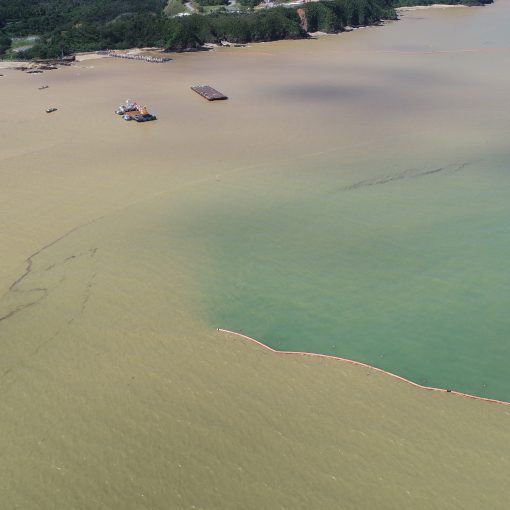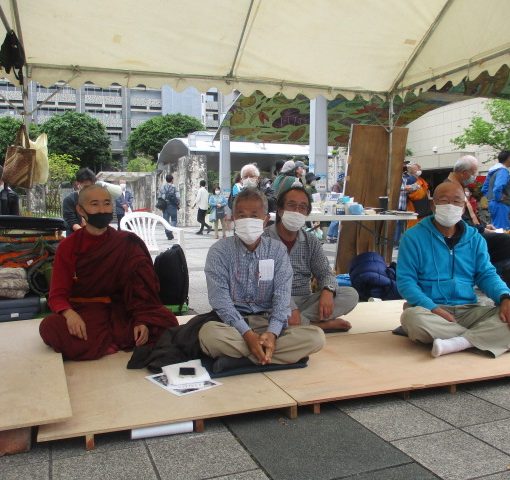I went to a site opposite Camp Schwab and climbed to a little hill where a small lighthouse used to stand. The hill gives a sweeping view of Oura Bay. It must have been a pride spot for Setake residents.
Something hideous sits beyond the swaying pampas grass; the floats extended as if to cut the Bay apart and about 12 large construction-work vessels. Many large cranes stand near the cape, which appears strange between the blue sea and sky.
The construction work is progressing on the Henoko side, while on the side of Oura Bay, nothing is going excepting two seawalls stretched into the Bay. The “soft ground” discovered in the Bay 5 years ago has forced them to revise the original landfill plan. The professors state that the soft ground improvement work to 90 meters under the water is infeasible. But the central government insists it feasible and proceeds on the improvement plan.
Looking over the Bay, I drew an image of the improvement work in progress. Out of 19 vessels equipped for soft ground improvement in Japan, eleven will gather in the Bay. I see 100 ships always crowding the Bay, including the cargo ships and security boats. It will be a bizarre picture; the Bay full of vessels and loud construction noises. And that will last for over the next ten years.
The sea was full of ships. Okinawans will recall the day, Apr 1, 1945, when the U.S. forces were about to land Okinawa. The sea off Yomitan-Son shore was black with the military vessels. This time, the Japanese government is filling the sea with construction vessels to trample Okinawa.
(In front of Camp Schwab Gate)
It is lively on Wednesdays when the women run the rally. Ladies hold a microphone one by one to sing her favorite song, which continues for quite a long time. They keep on singing, ignoring the riot police commander’s persuasion. They kept on singing until the police removed all the protesters from the sit-in rally. Somewhat perplexed riot police tried persuasion but sometimes ended up clapping their hands in response to the lively singing. Merrier, the better when you end up removed. The merrier, the longer we can engage ourselves in the rally.
A total of 184 trucks delivered construction materials.


(Ryukyu Cement Awa Pier)
Including 30 people from mainland Japan, nearly 20 people divided themselves to the pier’s entrance and exit to rally. The truck drivers give a different response to the protest rally; some with obvious irritation drive straight into the rally as if chasing us away, some wait quietly until we move out, and some wave their hands with smiles. They make a living through this job, but they are Uchinanchu (Okinawan), and I am sure they are aware that the earth and sand that they transport damage the sea of Okinawa. It is only natural to assume that they are feeling sorry. I do not believe many truck drivers working for the new base construction are proud of their work.
Four GoGo Dive members joined the rally. Eleven canoes delayed the cargo ships’ departure for over an hour. Loading to the cargo ships finished after completing 3.5 ships’ loading.
A total of 683 truckloads were loaded to the cargo ships.



(Motobu Shiokawa Pier)
Ten members of Motobu Shimagurumi (Island-Wide Conference Motobu) rallied all day long. No riot police came. Although the protesters were few, we successfully slowed the truck traffic down. It was worth rallying. In the afternoon, when we tied up the truck traffic for a long time. The riot police hurried over here from Awa.
A total of 516 truckloads of earth and sand was loaded into four carriers.

Number of dump trucks to date and percentage against the total
The estimation calculated on the basis of the number of ruckloads serves only as a reference.
Number of dump trucks which made delivery from December 2018 to the end of December 2019 114,601(1.39%)
| 24(Sat) | 26(Mon) | 27(Tue) | 28(Wed) | 29 (Thu) | 30(Fri) | |
| Awa | 0 | 259 | 936 | 683 | ||
| Shiokawa | 0 | 489 | 510 | 516 |
| Number of dump trucks ※ |
Weightt of earth/sand
※① |
Converted to volume
※② |
Volume per Total
※③ |
| 268,256 | 1,341,280t | 670,640㎥ | 3.320% |
※ Cumulative since Dec. 1, 2019
※① Calculated by assuming that the average truckload per dump truck would be 5 tons
※② Calculated by assuming that a specific weight of soil/sand set to be 2
※③ Percentage against 20.200.000m3, the total volume of earth and sand required for the landfill.




